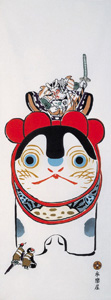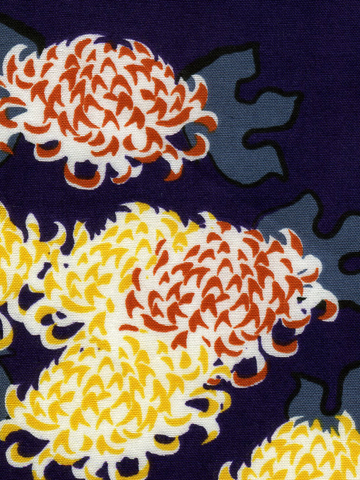Human Flower Project
Friday, December 14, 2007
Tenugui—Gift, Simple and Sublime
Wrap it, wrap in it, wrap with it.
 Momotaro
Momotaro
logo of Eirakuya, in Kyoto
a textile shop 380 years old
Our friend Eishi Adachi surprised us one winter with unexpected gifts (the best kinds). From Japan, he had brought back two beautiful textiles, hand-silkscreened with flowers. One bears a geometric design and plum blossoms—the emblem of hope and fortitude, harbinger of spring. The other, its background a rich purple blue, has yellow and orange chrysanthemums, the flower of the imperial family.
These are tenugui. In Japanese culture they were once considered fundamental tools of living—to wipe, bind, bandage. We suppose the Western equivalent would be a dishtowel or, better, a bandana, basic equipment for anyone doing physical work, be that house-cleaning, gardening, blacksmithing, plumbing….You need something to dry your hands with or hold the perspiration out of your eyes, to tie up a cut or carry home a few apples. They were always made of thin cotton gauze until a few decades ago when terrycloth (known as Seiyo—or Western—Tenugui) came on the market. Nowdays, tenugui have evolved from head scarves and mop-ups into beautiful handprinted keepsakes— to hang on a wall or decorate a table. Not only do they make wonderful gifts, they double as the perfect gift wrap.
 Chrysanthemum tenugui, from Eirakuya, in Kyoto
Chrysanthemum tenugui, from Eirakuya, in Kyoto
Photo: J. Ardery
Those Eishi brought us were made by a textile shop in Kyoto that’s nearly 400 years old—called Eirakuya. Take a look at their gorgeous website and note all the floral designs ~ morning glories, peonies, ferns, and what appear to be sweet gum leaves. We’ve only skimmed the surface. The company, with the well-accessorized kitty Momotaro as its logo, also sells handbags, hats, and t-shirts, but their reputation rests on the beautiful towels.
Tenugui, even these fine ones, are always unstitched. They’re meant to fray at the ends and be trimmed. Could this be yet another example of furisode—the aesthetic that Masashi Yamaguchi wrote about here on HFP several years ago? He described how the Japanese sense of beauty appreciates mutability, the ways time—without seeming to labor at it—works down the physical world.
Maybe some of this aspect of tenugui has been lost, now that the towels are less to be used, more to be admired. They’re considered a “necessary part of matsuri (festival) costume…. Also still today some shop owners and business firms distribute tenugui at their openings or simply as Thank-you gift.”
And in Kendo—Japan’s martial art of fencing—tenugui remains part of the uniform: traditional, practical, and philosophical. Jinichi Tokeshi explains, “The primary purpose of the tenugui in kendo is to absorb perspiration, cushion impacts to the head, and keep the hair neat. Often the tenugui display words of wisdom that are important in the training of kendo or words related to Zen. Japanese, by tradition, feel the head is one of the most sacred parts of the body, so wrapping the tenugui around the head has a special meaning in kendo…. It is strongly frowned upon to just crumple the tenugui and pack it in the bogu bag, because the tenugui will be damp and smell musty at the next practice. The instructors should teach these lessons to beginners.”
 Trying our hand at tenugui wrapping
Trying our hand at tenugui wrapping
Photo: Bill Bishop
With apologies to all students and masters of Kendo, and to Eishi, we had to try folding and wearing our chrysanthemum tenugui. The instructions we followed, found here, are the most elementary version of several you’ll find in Tokeshi’s book (check p. 37 ff.) No matter what you may think, we feel spiffy—if not quite ready for sword-fighting.
Many thanks to Eishi for this enduring gift. We’re not sure about shipping schedules from Kyoto, but who knows? There may be time to order and receive several of these marvelous pieces by December 25th for the cowboy, art historian, dishwasher, blogger, girl scout, and ceremonial fencer on your list.




